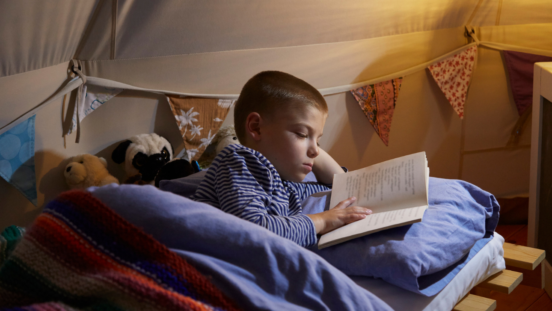Get your kids’ sleep routine back on track in the new school year

If you threw sleep schedules out the window over the summer holidays and are now paying the price, this article is for you.
It’s pretty common; we get to the end of the year and everyone is exhausted. Christmas parties and summer holidays often mean your little ones are staying up much later than they normally would and sleeping in later too.
It’s a well-deserved rest from routine for the whole family. However, when it comes time to get back to school, kindy or childcare, it can be difficult to switch back to set bedtimes and wake times.
Professor Harriet Hiscock, a paediatrician from the Murdoch Children’s Research Institute with over 20 years of experience in child sleep has some helpful tips to get us all back on track.
How to get back into a routine
Give their screens a bedtime
Remove screens from the bedroom. The blue light from screens blocks the melatonin in our brains, making it more difficult to sleep. This goes for adults too. If you have trouble sleeping, an old-school physical book won’t block your melatonin and will help you to fall asleep more easily.
Wakey wakey!
If your child is finding it difficult to wake up in the morning, open their curtains or blinds after they go to sleep. The morning sunlight will help correct their circadian rhythm, turn off their melatonin and re-set their body clocks.
Praise for great timekeeping
Rewards work well for young kids too. Set up a lucky dip system – if your child is in bed at the right time and out of bed in the morning at the right time, they get to choose a lucky dip gift.

Anxiety check-in
For some children, there is a lot of anxiety around a new year with new teachers and new kids in the class. This can contribute to them not sleeping well.
Parents should choose a time that is not close to bedtime to talk through those issues. Speaking about them right before bedtime can keep the concerns top of mind and cause the child even worse sleep.
A good time might be when you and the child are in the car together or when you are out for a walk – sometimes kids open up when they don’t have to look at you directly.
Ask what exactly they are worried about and help them come up with a couple of strategies to try.

Professor Harriet Hiscock has helped the MCRI produce a range of children’s books titled Sleep with Kip. There are six books in the series and each one tackles one of the common sleep issues with kids. These books can help with sleep issues all year round and a couple in particular can help with new year sleep issues or daylight savings issues.
If your child has a tendency to get out of bed several times – for a drink or to tell you something then to go the toilet – it can be exhausting. The Sleep with Kip book, The Old Bedtime Pass Puncher suggests the ‘bedtime pass’ technique. Kids are given one pass out ticket. They can use it once for whatever reason but have to hand it over to you and stay in bed after that.
Pick Your Own Nose is another in the series that helps a child to self-settle. If your little one feels they need you in the room with them to fall asleep, this book can help build the confidence they need to do it on their own.
If anxiety is something your child is dealing with, the Sleep with Kip book, A Beach in the Bedroom, can help the child to calm down and almost mediate themselves to sleep. It’s great for little worriers.




